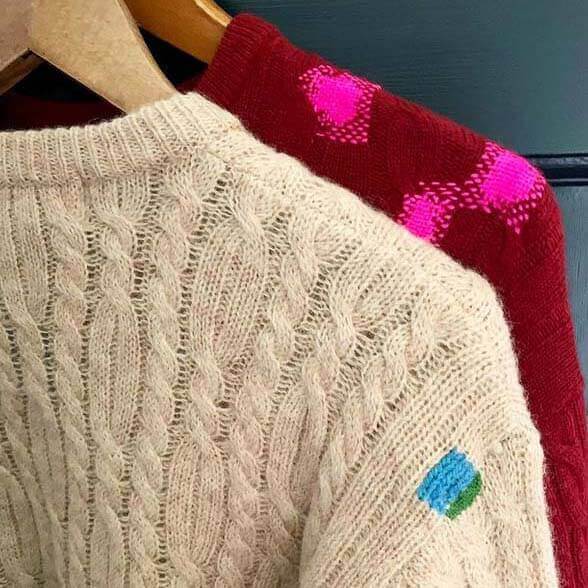
When the worlds of slow living, creativity and an environmental conscience come together, the results are often very beautiful. A perfect example of this is the inspirational work of Lizzie, the talented repairer of much cherished garments at Little Moth Mends. With our passion at BIBICO for the virtues of wool and our love of knitwear, we wanted to know more about how the lifespan of our garments can be extended by clever mending. So, who better to ask than Bath-based Lizzie, whose innovative mending skills have become much sought after and admired…
Where did your mending journey begin?
I love clothes but was aware of how damaging the fashion industry is to the planet. I started to buy only second hand and became more creative about re-wearing clothes I already had. During lockdown I taught myself to darn and I enjoyed the meditative repetition of mending by hand, the slow pace and the creativity of it. It’s so rewarding to bring clothes back to life through mending, and make them unique to you. It’s an antidote to fast fashion and a simple way of reducing our environmental impact.
What techniques and materials do you use?
I darn knitwear, often using contrasting colours. I take inspiration from the Japanese tradition of Kintsugi, treating repair as part of a garment’s history, something to celebrate rather than disguise, so I choose to visibly mend clothes. Colour and textiles are my favourite things, so visible mending is a perfect combination for me. There are many ways to darn, some techniques are simple, some take a little practise. You don’t need much, a needle, some yarn, a darning mushroom if you have one (but you can also use everyday objects such as jam jar lids, lemons or even your phone). I use all sorts of yarn, from Japanese cotton thread, to mohair and merino wool, and a growing collection of antique darning mushrooms. I love the idea of moths being my design collaborators.
What are you working on at the moment?
At the moment, several mending commissions - a Missoni scarf, and some cashmere sweaters. I always have a big pile of family mending to get through too!
Are some things harder to mend than others?
In terms of knitwear a finer knit is trickier to mend; you use the same techniques, but the stitches are smaller and it takes more time. When you’re investing in clothes it’s always worth checking the label to see what your clothes are made of and buy natural fibres where possible. Clothes which contain stretch are tricky to mend. A heavy weight knit is a joy to repair.
Have you found mending has become more popular recently?
I think people are becoming more aware of the environmental cost of discarding clothes, of slowing down and realising that they have enough, and adopting a ‘make do and mend’ attitude. This makes environmental sense for the state of climate emergency we are living in. Darning and mending are old skills but so relevant to now. I think everyone can enjoy it and I’m really happy to see demand for my workshops. I love sharing this new/old life skill with others.
Thanks to Lizzie at Little Moth Mends
To find out more about Little Moth Mends, including upcoming workshops dates visit @little_moth_mends







